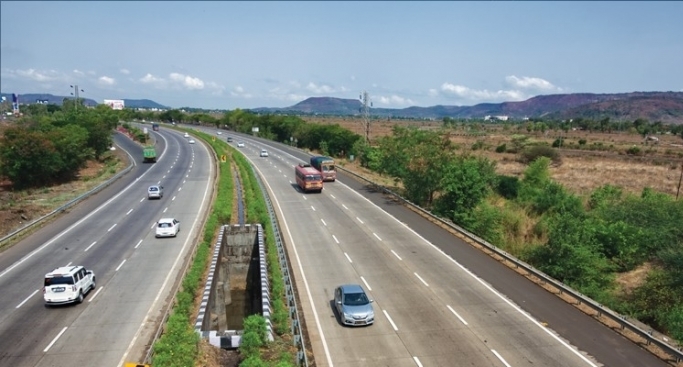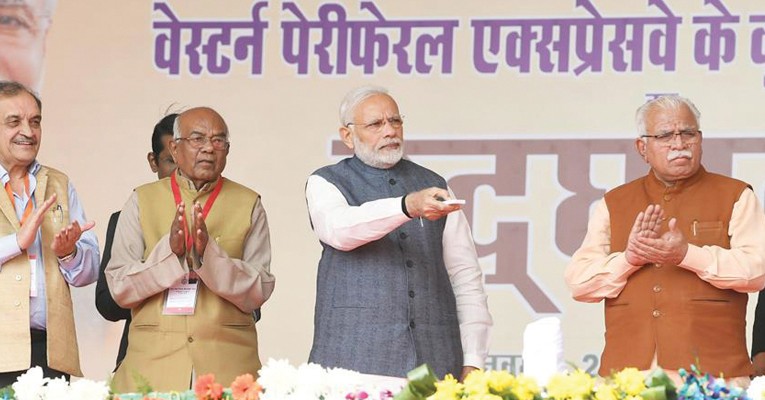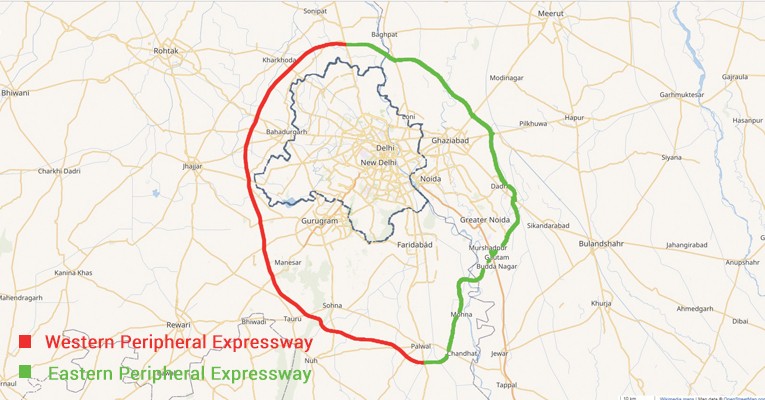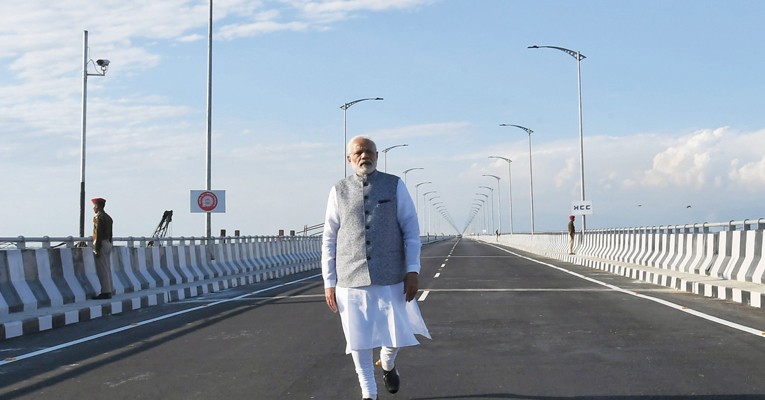FROM MAGAZINE: Pumping energy into India’s arterial roads
India is moving ahead with a pan-nation scheme to improve the road network to bridge critical infrastructure gaps through corridor-based development. A timely completion can give a solid foundation for the ushering in of a better India.

India is moving ahead with a pan-nation scheme to improve the road network to bridge critical infrastructure gaps through corridor-based development. A timely completion can give a solid foundation for the ushering in of a better India.
Shreya Bhattacharya
In November 2018, India’s industrial and logistics sector got a boost, when it was reported that the acquisition of land in Haryana for the Delhi-Mumbai Expressway was complete. While the acquisition of land in other states namely Rajasthan, Gujarat, Madhya Pradesh and Maharashtra is ongoing, the news at least hinted that the project is on fast track.
Many are in the waiting as an arduous 24-hour journey will come down to only 12 hours, when the expressway is opened for traffic. The eight-lane expressway between the two metropolitan cities will reduce the existing distance of 1,450 km by road to about 1,250 km and will be a signal-free stretch.
K Satyanarayana, co-founder and director of Ecom Express says, “One of the most eagerly awaited highway projects is the Mumbai-Delhi Expressway which could cut logistics charges by bypassing the two largest and most populous cities in India. Touted as one of the busiest lanes in South Asia, the bottle neck surrounding the corridor needs to be replaced by a steady pace of development thus, enhancing the execution speed.”

PM Narendra Modi inaugurating the Kundli-Manesar Section of the Kundli-Manesar-Palwal (KMP) Western Peripheral Expressway

Satyanarayana goes on to add that the project will also boost investments, manufacturing, the job market and growth.
The eight-lane road crossing through Sohna in Gurugram will link the Western Peripheral Expressway (WPE) with the DND flyway (Delhi Noida Direct Flyway) in Delhi. Earlier in November 2018, the opening of the WPE gave the traffic and pollution choked national capital, an opportunity to decongest itself by diverting heavy traffic that passes through Delhi but is bound for other parts of the country, through its third ring road. The first leg of the project, the Eastern Peripheral Expressway, was opened earlier in July.This expressway has been completed almost 15 years after it was first conceived.
Nevertheless, these are just few of the many highway projects currently underway. Overall, if the current scenario of Indian roads is to be considered, it has to go a long way and still does not bode well with the country’s growing economic activity. Some of the other major projects, which will be instrumental in sustaining the momentum of development in the years to come, are Delhi-Meerut Expressway, Vadodara-Mumbai Expressway, Bangalore-Chennai Expressway, Delhi-Amritsar-Katra Expressway, Nagpur-Hyderabad-Bangalore (NBH) Expressway, Kanpur-Lucknow (KL) Expressway etc.
Although the inefficiency in transportation of goods and services still exists across the country, there is definitely a change in momentum, with projects like Bharatmala Pariyojana.
According to Shubham Jain, group head & VP for corporate ratings at investment information and credit rating agency ICRA, the Bharatmala Pariyojana has the potential to change the entire landscape, if implemented as per plan. “The new approach is unlike the project-based approach adopted in the past (different stretches in different geographies) which led to inconsistent infrastructure development across corridors.”
In October, 2017, the cabinet had approved the Bharatmala Pariyojana Phase-I along with other programmes which involves around 83,000 km (including Bharatmala Pariyojana Phase-I of 24,800 km) of national highway development by FY2022. The Pariyojana aims to bridge critical infrastructure gaps through corridor-based development which is a more scientific approach, desirable in the long-term, as it takes a holistic view on the overall network.
In order to expedite pre-construction activities and bring in more efficiency and transparency in the process of land acquisition, the government has opted for a digital route. Unlike in the past, wherein projects were awarded without acquiring requisite land, the Bharatmala awarding process is expected to be more transparent with tighter pre-requisites; 80 percent of RoW (Right of Way) for BOT (built, operate and transfer) projects and 90 percent for the EPC (engineering, procurement and construction) projects have to be available before awarding.
The Bidder Information Management System (BIMS) was developed to streamline the process of pre-qualification of bidders for contracts on EPC Mode. Furthermore, the Bhoomi Rashi portal, the government’s one-point platform for online processing of land acquisition and notifications, is being used extensively. The BIMS and Bhoomi Rashi portals have further been linked with Public Financial Management System to facilitate real time payment to beneficiaries.
Apart from this, Jain mentions that the government is also “prioritising stretches with detailed project reports and readily available RoW – including the grand challenge mechanism wherein projects are taken up on a fast-track basis if sufficient and timely land is made available by the state governments.”
A vital question remains whether these measures have actually enhanced the pace of construction in 2018-19, an year declared by Ministry of Road Transport & Highways as the ‘Year Of Construction’.
As per latest figures, in the first nine months of FY 2018-19, 5,759 km has been completed against 4,942 km up to same period in last year. This was versus a set target to complete all ongoing projects that had been awarded up to 2015-16, while placing the highest ever target of constructing at least 12,000 km of national highways as against 9,829 km achieved during 2017-18, and make special efforts to take this length to 16,000 km.
Although there has been an increase in the pace, but looking at the current figures, touching the targets looks a far cry by all means. Overall, more than about 61,300 km length of road projects, costing more than Rs 6.48 lakh crore, are in progress at present. The balance ongoing works (which have been awarded, appointed dates declared and works going on at sites) are more than 30,200 km during the year, informs the Ministry.
Apart from this, even the FY2022 targets are highly ambitious, think industry experts. “Given the past track record, completing 83,000 km, by FY2022 looks extremely ambitious. However, in terms of planning and approach, the situation has improved a lot when compared to the past,” says Jain.
It goes without saying that road infrastructure is a critical enabler for logistics sector. Industry players say timely implementations of road projects could certainly help in reducing the cost of operations and result in efficiency around turn-around times. As of now, since a large part of the road network that India needs is yet to be built, they are aligned with the current available infrastructure and finding ways and means to optimise efficiency and cutting down transit times.
Evaluating the planning, strategy and pace of development under the Bharatmala Pariyojana, Debashis Dutta, director, industrial services, JLL India, says, “India is currently witnessing $72 billion (approx.) expenditures towards cost of transportation and around 65 percent of freight movement through highways and roads. Cost of transportation includes ancillary cost towards safety of cargos, maintenance of vehicles and daily mileage of carriers apart from unavoidable cost of fuel and tax/ cess/ toll. Efficient and comprehensive planning in improvement of road connectivity can help to optimise the ancillary cost component a lot. In addition, certainty in time bound delivery mechanism through availing shortest transit distance can have significant positive impact on the product supply chain by way of lower buffer stock and cost of storage.”
Slow land acquisition remains a challenge
Even though many measures have been taken to bring in transparency and efficiency in the pace of construction, slow land acquisition remains a major challenge even today. Speaking about the biggest hurdles,Jain says, “Fragmented land holdings, lack of clear land titles, dependence on local authorities, inadequate land acquisition plan at the time of preparing detailed project reports (DPRs) and lack of methodology for compensation are the major difficulties faced during land acquisition. In about 80 percent of the delayed road projects, the reason for delay is attributable to unavailability of RoW which is the responsibility of the awarding authority. Another major challenge for Bharatmala is compliance to the Right to Fair Compensation and Transparency in Land Acquisition, Rehabilitation and Resettlement Act, 2013 (RFCTLARR) which led to increase in compensation by four times the market value in rural areas and twice the market value in urban areas.”
This has resulted in a steep increase in acquisition cost to upwards of Rs 2.50 crore per hectare currently, as against Rs 0.90 crore per hectare in FY2014. Land acquisition cost as a percentage of total project cost for the NHAI projects was at nine percent in 2009, this has increased to 16 percent in 2012 and; for some of the recent expressway projects, the land acquisition cost is estimated to be in the range of 37-55 percent of total project cost, informs Jain.
Quoting the Minister of State for Road Transport and Highways, Dutta says, 435 infrastructure and road projects are stuck and pending for completion and they are delayed mainly due to land acquisition, utility shifting, non-availability of soil/aggregate, poor performance of contracts, environment/forest/ wildlife clearances. He further adds, “Study indicates that $40 billion (approx.) is current cost of warehousing and inventories and this can be optimised through appropriate supply chain planning and its implementation. Since, these warehousing space are available predominantly on medium term (7-9 years) with lock-in-period, delay in road implementation have adverse impact in their cost of operation and storage.”
Financial instability stalling projects
Due to these and many other ambiguities, many projects run into financial woes. Jain highlights policy interventions brought by the government that have revived 73 projects of length around 8,310 km.
Jain says in order to propel the underperforming toll road projects, premium deferment in stressed toll road projects have been allowed that helps in rescheduling of premium, committed by concessionaires during bid stage. Also there is a provision for a rationalised compensation to concessionaires for languishing BOT projects, if the delays are not attributable to concessionaires.
This he says, “allows extension of concession period for BOT (Toll) projects keeping original operation period unchanged. For BOT (Annuity) projects, payment of missed annuities corresponding to actual delay is allowed.”
Few under construction projects in the past got delayed because of weak credit profile of the sponsors. Jain adds, “These have witnessed considerable delays in terms of execution and missed the project completion deadline. One-time fund infusion scheme has been introduced by NHAI for expediting projects which are stuck midway for want of funds – wherein NHAI would infuse fund to enable completion of project. This is subsequently recovered from project cash flows once it becomes operational. This had helped some of these projects achieve completion.”
On the finance front, the Ministry informs, “National Highways Authority of India (NHAI) did a successful financial closure of its first project under Toll-Operate-Transfer (TOT) this year and offered 586 km of national highways under the second bundle. The first TOT bundle of 9 projects, totalling approximately 681 km of roads in two states of Andhra Pradesh and Gujarat, was awarded earlier during the year for Rs 9,681 crore, which was 1.5 times the Authority’s estimate.
NHAI also got an unsecured loan of Rs 25,000 crore from State Bank of India for 10 years with three years of moratorium on repayments. This is the largest amount of loan to have been sanctioned to NHAI in one stroke by any institution. This is also the largest long term unsecured loan sanctioned by SBI at a time to any entity.”

PM Narendra Modi at the dedication of India’s longest Bogibeel Bridge to nation,
at Dibrugarh, Assam
Accessing India’s Northeast region
North East (NE) India is geographically connected to the rest of the country, by a narrow corridor of land, flanked by Nepal and Bangladesh. The only link it had was through the Siliguri Corridor popularly known as the chicken neck area in North West Bengal. According to a recent NITI Aayog publication, one of the major constraints hampering economic growth in the NE region is inadequate infrastructure in terms of limited air, rail and road connectivity.
Around Rs 1,90,000 crore worth of projects have been sanctioned for the construction of road projects for over 12,000 km in the NE region, says the Ministry. The projects being executed by NHIDCL (National Highways and Infrastructure Development Corporation) are to the tune of Rs 1,66,026 crore, covering 10,892 km of roads in all the eight NE states. Projects costing Rs 17,257 crore have been allotted to the respective state PWDs. Further, projects costing Rs 7,000 crore are entrusted to the NHAI.
So has the situation really improved in terms of accessing the far flung areas of the NE region? Satyanarayana says, “The NE, once regarded as land-locked because of poor accessibility and difficult terrain, is emerging as a growing region for not only e-commerce firms but also transporters and logistic players besides being a consumption driven region. This is due to the government’s focus on development of infrastructure in the region.”
He further adds, “The pace of road construction in the NE has definitely fastened and this has fueled demand as well as smoothened supply bottlenecks in the NE states. Road conditions have also improved in some states such as Assam, Meghalaya and Arunachal Pradesh but still a lot remains to be done in the region. With the running of many National Highways projects in the northeastern states, the connectivity will certainly see more improvements. The recent launch of the Bogibeel Bridge, India's longest rail-road bridge, will greatly reduce distance between Assam and Arunachal Pradesh.”
Enhancing cross border trade
Meanwhile, highlighting the geo-economic significance of the NE region, in terms of cross border trade, Dutta says, “Development of 4-lane trilateral highway linking India (Moreh in Manipur) with Mae Sot (Thailand) via Myanmar which will be expanded to Laos, Cambodia and Vietnam enhance economic importance of the region. Dedicated Ministry of Development of North Eastern Region, being the nodal Ministry for North East, for coordinating Central Ministries/Departments is major governance initiative. All these initiatives in turn increase visibility of north eastern part of the country as a sustainable economic contributor to the nation.”
Expressing similar thoughts, Dutta says, “Indian ports and major highways are acting as catalyst to the supply line of Nepal and Bangladesh. Proposed ASEAN highway is major boost to this relationship focusing alternative route to north east and neighboring countries of extreme eastern states of India. Aim to become transshipment hub, these two countries have significant importance in logistics sector by way of Free Trade Warehousing Zones, dry ports (ICD/CFS) etc. in eastern part of the country. Efficient highway corridors help to escalate importance of these infrastructure along these corridors.”
Development of a major road system is an orderly and continuous process. Also, it is high time to create support infrastructure primarily for warehousing space and removal of bottlenecks to ensure seamless movement while connecting corridors. Building highways is the agenda, but special emphasis should also be given on providing connectivity to far-flung border and rural areas including the tribal and backward areas for inclusivity. Experts say that although the progress so far is encouraging, the real benefits will be witnessed upon timely completion of these projects.



